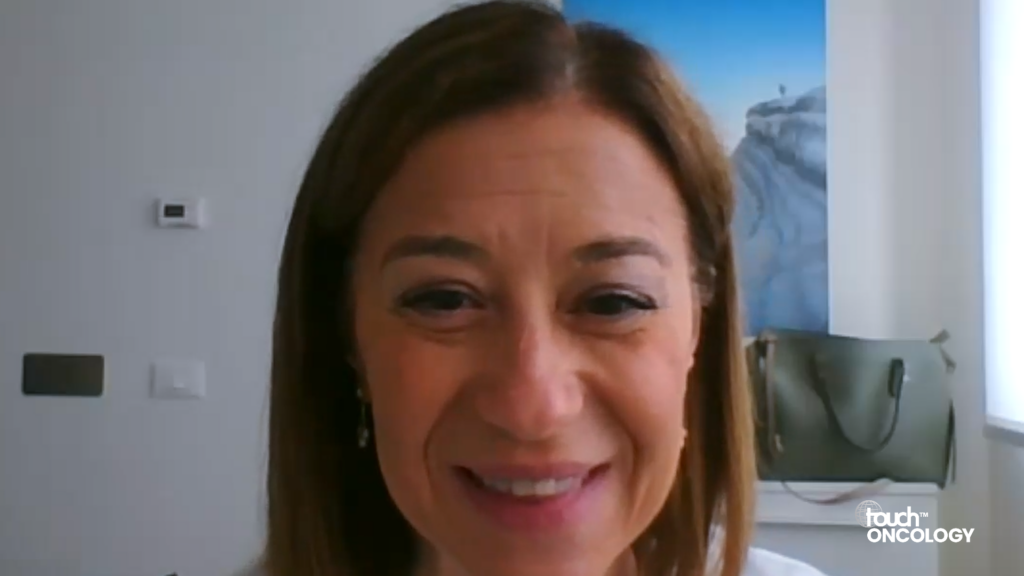The ATHENA trial evaluated the effectiveness of rucaparib (RUCA) monotherapy (MONO) and rucaparib combined with nivolumab (NIVO) (COMBO) in patients with advanced high-grade ovarian cancer (AHGOC). In the MONO arm, rucaparib showed sustained progression-free survival (PFS) of 20.2 months after first-line treatment. However, the COMBO arm did not improve PFS, with median PFS being shorter than in MONO (15.0 vs 20.2 months). The study also explored subgroups with homologous recombination deficiency (HRD) and PD-L1 expression. COMBO had more frequent treatment-related adverse events, but the safety profiles were consistent with previous studies.
Dr. Bradley J Monk (Florida Cancer Specialists & Research Institute, West Palm Beach, FL, USA) presented the late-breaking abstract ‘ATHENA-COMBO, a phase III, randomized trial comparing rucaparib (RUCA) + nivolumab (NIVO) combination therapy vs RUCA monotherapy as maintenance treatment in patients (pts) with newly diagnosed ovarian cancer (OC)’ (LBA30) at the European Society of Medical Oncology Congress 2024 on 13–17 September 2024 in Barcelona, Spain.
Questions
- What was the rationale for adding nivolumab to rucaparib, and why was it expected to improve PFS?
- Could you tell us more about these findings, and how do you interpret the shorter median PFS observed in the COMBO group?
- What are the implications of these findings for future combination therapies in advanced high-grade ovarian cancer treatment?
Associated abstract
Monk B et al. LBA30 – ATHENA-COMBO, a phase III, randomized trial comparing rucaparib (RUCA) + nivolumab (NIVO) combination therapy vs RUCA monotherapy as maintenance treatment in patients (pts) with newly diagnosed ovarian cancer (OC). European Society of Medical Oncology. Abstract LBA30.
Disclosures: Bradley Monk discloses acting as a consultant/advisory board member for GSK, AZ, Pharma&, MSD, receiving grant/research support from GSK, AZ, Pharma and MSD; Advisory Board member for GSK, AZ, Pharma& MSD; Honoraria received from GSK, AZ, Pharma&, MSD; and participant in the Speaker’s Bureau with GSK and AZ.
This content has been developed independently by Touch Medical Media for touchONCOLOGY. It is not affiliated with the European Society of Medical Oncology (ESMO). Views expressed are the speaker’s own and do not necessarily reflect the views of Touch Medical Media.
Transcript
Good morning, good day. My name is Brad Monk. I’m a gynaecologic oncologist here at Florida Cancer Specialists in West Palm Beach, Florida. I’m also the Vice President and Director of the [Gynecologic Oncology Group] GOG Partners Organization, and it’s my pleasure to be with you to talk about what’s very near and dear to my heart. How to help patients live better and live longer.
1. What was the rationale for adding nivolumab to rucaparib, and why was it expected to improve PFS?
So I’ve spent the better part of two decades trying to evolve what I call maintenance treatment. Although we may not be able to visually identify cancer after frontline treatment of advanced ovarian cancer, it’s still there. And so the idea was to capitalize on what we’ve done before. And we have several studies, as you know, with single agent PARP inhibitors, olaparib, rucaparib and now a niraparib.
So, each study is a little different. This study focused on rucaparib. Rucaparib is a unique PARP inhibitor and has been approved in Europe based on the ATHENA–MONO [trial]. ATHENA–MONO was published two years ago in the Journal of Clinical Oncology, and presented at ASCO also in 2022. And the idea was to take single agent PARP inhibition and make it better. To make it better by adding an immune checkpoint inhibitor, nivolumab.
And why would that work? Well, it was based on three theories, which I think are probably true at some level.
Number one: that rucaparib increases PD-L1 expression. So it increases the target for nivolumab.
Number two: it’s well documented that PARP inhibitors such as rucaparib impede DNA repair, thereby increasing DNA damage, thereby increasing abnormal cytoplasmic DNA, which interacts with the cGAS sensor, cyclic GMP-AMP synthase sensor, thereby activating the sting pathway stimulation of interferon genes.
Number three: because DNA repair is interfered with, there’s a higher mutational burden.
So, we got more PD-L1 expression and enhanced immune response and an increased neoantigen level. And, really, it was the right thing to do. This trial was designed six years ago. We utilized all the science, all the data that we had, and it didn’t work.
2. Could you tell us more about these findings, and how do you interpret the shorter median PFS observed in the ATHENA-COMBO group?
ATHENA-COMBO showed that when nivolumab is added to the established standard-of-care rucaparib, that it did not improve the risk of progression-free survival or death. And in fact, it may be even suggested there was a decrement.
Why would that happen? Well, I’m not sure. But I think there’s some interesting signals in that number one, there was no biomarker enrichment. Nivolumab did not improve the outcome of rucaparib even in the HRD or BRCA subsets.
We also looked at PD-L1 expression. It did not improve the outcomes even in PD-L1 positive tumours. And in fact, what it did is made it more difficult to tolerate the rucaparib, which is really important. The number of cycles of rucaparib, nivolumab versus rucaparib alone was 75% less. You got less rucaparib if nivolumab was at it. It’s almost like nivolumab got in the way. There was also less dose intensity.
And why would that happen? Well, there was more, neutropenia, thrombocytopenia, liver function test abnormalities and even neutropenic fever. So not only did nivolumab not improve clinical outcomes, but it increased toxicity as measured by those laboratory-based events, and decreased dose intensity of the PARP inhibitor, which I think is we all agree is very, very important in this setting.
3. What are the implications of these findings for future combination therapies in advanced high-grade ovarian cancer treatment?
It’s hard for me to admit, but this is the third negative trial that we’ve had in the frontline opportunity with checkpoint inhibitors. I had the opportunity in a study called JAVELIN Ovarian 100, where we just did avelumab with chemotherapy and, in maintenance, didn’t work.
And then Professor Katie Moore did atezolizumab plus bevacizumab. Again, continued in maintenance. It didn’t work. And now this trial shows that immunotherapy added to PARP inhibitor – strike three, you’re out. So I think that we have answered the question that frontline immunotherapy is not only not a good idea, but it’s potentially a bad idea because of the potential decrement.
But there are some opportunities here. The first is that it really validates the importance of PARP inhibitor maintenance, and it adds two additional years of ATHENA-MONO where the initial hazard ratio (two years ago presented and now EMA approved) is 0.54. And with two additional years of follow-up, it’s 0.56. So it’s a sustained effect. It adds confidence, and I’m happy that it is now EMA approved, and I’m confident that at some point, maybe even soon, that it’ll get FDA approved.
And as you know, niraparib is already approved in the all-comer population, which is what we’re talking about through PRIMA. Another opportunity that I’m passionate about and the overall survival of PRIMA was also presented at ESMO 2024. And what that more mature dataset showed us, there’s no survival decrement.
So as you know, in the recurrent setting, some of the PARP indications in the US have been restricted because PARP inhibition might induce platinum resistance. That’s a different limitation than what’s happened in Europe. But I think PRIMA overall survival maturity was now 62.5% of the patients that have died proves that niraparib, like rucaparib, is a very good idea in the all-comer population, not only BRCA and HRD, but in the all-comer non BRCA and non HRD. I think ATHENA-MONO and PRIMA are complementary.
So what it shows is that in the all-comer population, the non-BRCA and non-HRD, what some people call the HRD test negative or the HR proficient, that there is a benefit. No question. And a hazard ratio of 0.67 in my mind is pretty good.
And Rucaparib monotherapy now, through interpretation in the lens of ATHENA-COMBO, the two years of additional follow-up is really, really encouraging. Two studies complimentary. If you’re not convinced, you should be now. And the final overall survival with PRIMA with 62.5% of the patients, unfortunately, who have died, there’s no survival decrement.
This idea that in platinum sensitive maintenance treatments, such as ARIEL3, such as NOVA, maybe even Study 19, that there might be an induction of platinum resistance with PARP views didn’t happen. Didn’t happen in the PRIMA with maturation of the OS endpoint.
So we have two complementary studies that PARP inhibitors are important. We have additional data from rucaparib. It’s sustained. And now we have PRIMA OS where there’s no decrement.
I get it. I wish that PRIMA would have showed an overall survival advantage, but it’s unrealistic to think that in a study where there’s a long post-progression survival, where there’s crossover and multiple intervening therapies, four, five, six, seven lines of therapy and maybe even surgeon radiation, that we could do that. And this study wasn’t powered for overall survival.
So my advice to you is let’s not cross-trial compare. Let’s not say that ‘SOLO1 compared to PRIMA versus…’. Let’s not do that.
But let’s message that PARP maintenance treatment, whatever the PARP inhibitor is, is really, really important for improving survival, improving outcomes, and sustaining patients to be progression free and living better.
Interviewer/Editor: Gina Furnival
Cite: Monk BJ. Addition of nivolumab to rucaparib did not improve clinical outcomes in newly diagnosed, advanced, high-grade ovarian cancer. touchONCOLOGY. October 2, 2024.









